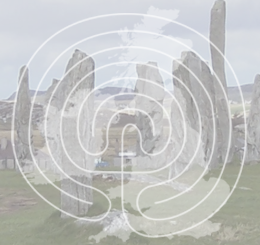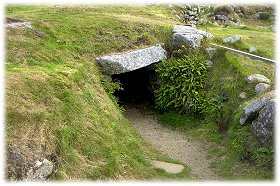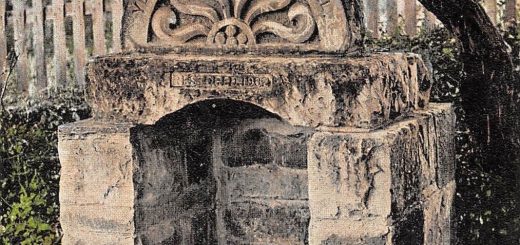Sandford’s Well, Newton Nottage
The following description by Wirt Sikes of Newton Nottage’s well was published in his ‘British Goblins’ (1881). ‘At Newton Nottage, Glamorganshire, a holy well called Sanford s is so situated that the water is regulated in the well by the ocean tides. From time immemorial wondrous tales have been told of this well, how it ebbs and flows daily in direct contrariety to the tidal ebb and flow. The bottom of the well is below high-water mark on the beach, where it has an outlet into the sea. At very low tides in the summer, when the supply of water in the well is scanty, it becomes dry for an hour or two after low water. When the ocean tide rises, the sea-water banks up and drives back the fresh water, and the well fills again and its water rises. The villagers are accustomed to let the well-water rise through what they call the ‘nostrils of the well,’ and become settled a little before they draw it. Of course this phenomenon has been regarded as something supernatural by the ignorant for ages, and upon the actual visible phenomena have been built a number of magical details of a superstitious character.’
One of the earliest mentions of the well may have been by William Camden (Born 2 May 1551 – Died 9 November 1623) in his ‘Britannia’ (1586), a chronological survey of Great Britain and Ireland.
“There is a remarkable Spring within a few miles of this place (as the learned Sir John Stradling* told me by Letter) at a place call’d Newton, a small village on the west side of the river Ogmor, in a sandy plain about a hundred paces from the Severn shore. The water of it is not the clearest, but pure enough and fit for use: it never runs over; and such as would make use of it, must go down some steps. At full Sea, in Summer-time, you can scarce take up any water in a dish; but immediately when it ebbs, you may raise what quantity you please. The same inconstancy remains also in the winter; but is not so apparent by reason of the adventitious water, as well from frequent showers as subterraneous passages. This, several of the Inhabitants, who were persons of credit, had assur’d me of. However, being somewhat suspicous of common fame, as finding it often erroneous, I lately made one or two journeys to this sacred Spring; for I had some thoughts of communicating this to you. Being come thither, and staying about the third part of an hour (whilst the Severn flow’d, and none came to take up water) I observ’d that it sunk about three inches. Having left it, and returning not long after, I found the water risen above a foot. The diameter of the Well may be about six foot. Concerning which my Muse dictates these few lines;”
Te Nova-Villa fremens, odioso murmure Nympha
Inclamat Sabrina: soloque inimica propinquo,
Evomit infestas ructu violenter arenas.
Damna pari sentit vicinia sorte: sed illa
Fonticulum causata tuum. Quem virgo, legendo
Litus ad amplexus vocitat: latet ille vocatus
Antro, & luctatur contra. Namque æstus utrique est.
Continuo motu refluus, tamen ordine dispar.
Nympha fluit propius: Fons defluit. Illa recedit.
Iste redit. Sic livor inest & pugna perennis.
Thee, Newton, Severn’s noisy Nymph pursues,
While unrestrain’d th’ impetuous torrent flows.
Her conqu’ring Surges waste thy hated Land,
And neighbouring fields are burden’d with the Sand.
But all the fault is on thy fountain laid,
Thy fountain courted by the amorous Maid.
Him, as she passeth on, with eager noise
She calls, in vain she calls, to mutual joys.
He flies as fast, and scorns the proffer’d love,
(For both with tides, and both with different move.)
The Nymph advanceth, strait the Fountain’s gone,
The Nymph retreats, and he returns as soon.
Thus eager Love still boils the restless stream,
And thus the cruel Spring still scorns the Virgin’s flame.
*Possibly Sir John Stradling, 1st Baronet (Born 1563 – Died 9 September 1637) a politician, scholar and poet.




Recent Comments